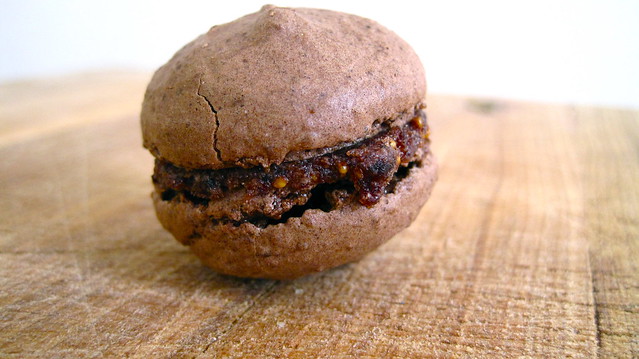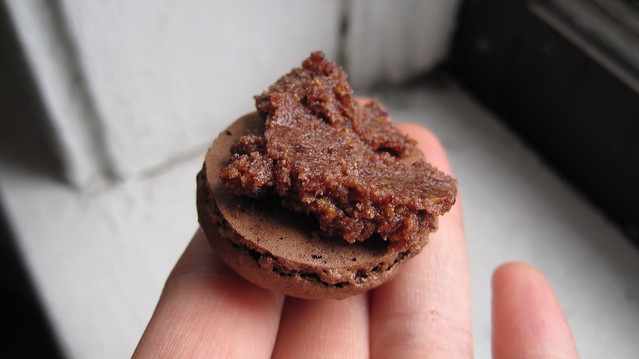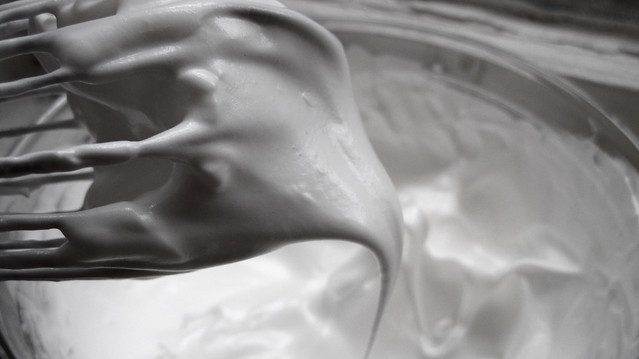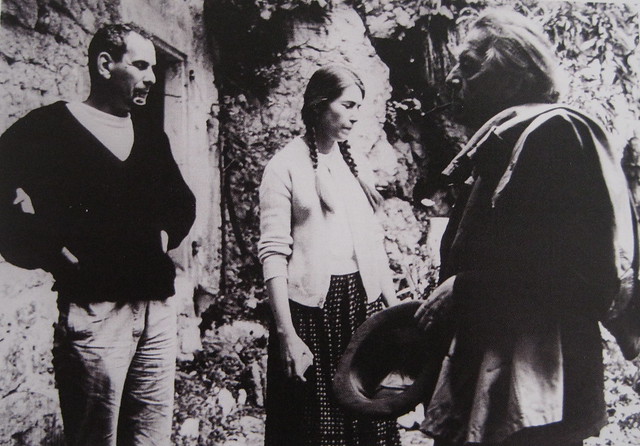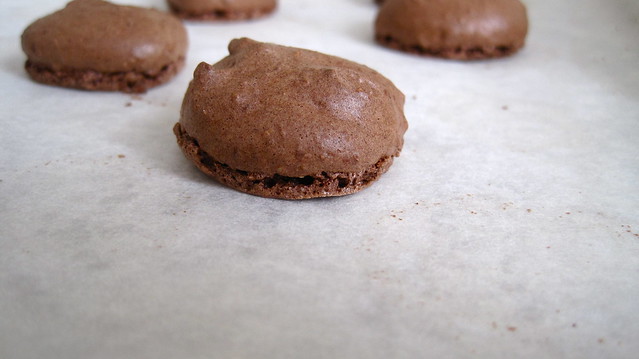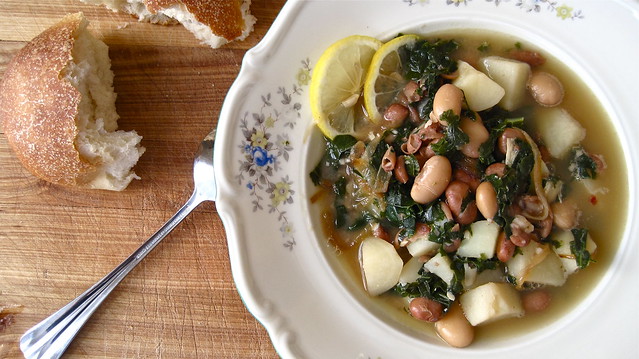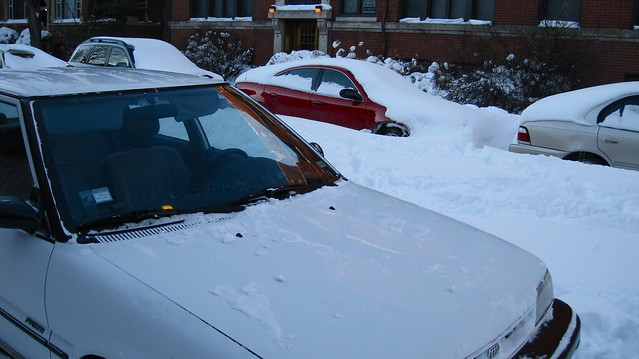Having been overtaken by a pretty serious case of macaron fever recently, I've looked into getting what appears to be the book of all macaron books, Pierre Hermé's Macaron. How is it that a book that is (a) not out of print, and (b) a trifling 30 EUR (that's roughly 41 USD) at Hermé's Paris boutique, available in the US for typically no less than $200? That is unbelievable. If you, dear reader, live in Paris and understand culinary obsession, I kindly ask that you get in touch with yours truly.
Monday, February 28, 2011
Saturday, February 26, 2011
With practice
A good macaron is really something special. It takes you by surprise--delicate, almost cloud-like, but intensely flavoured beneath its crackly, colourful shell. And, by all counts, such a macaron is not easy to come by--it's a bit of a technical achievement to get that smooth, shiny dome, that pretty, ruffled foot, that satisfying chew. I'm certainly not there yet with my macarons, but making them was something that I had to try and something that I intend to keep working at.
Admittedly, there are perfectly good macarons at the bakery down the street, and if this were all about getting my fill, I could probably just pop in there more often. But this, this is about the challenge. I'm learning to master something, bit by bit. Whipping egg whites to stiff peaks by hand? No problem. Folding ground almonds and sugar into those egg whites? Sure thing. Piping perfect macaron shells? Well, I'm still working on that one. Every new batch has come out just that much better than the last. I like seeing the improvement right on the half-sheet. It feels good to be working towards something tangible.
So, don't be deterred by the technical demands because that's all they are--demands that can be met with a bit of patience and practice. What's more, once you've gotten a handle on the basics, there isn't much to limit you. Stick to standard flavours like pistachio, lemon, and chocolate, or dream up your own (take, for instance, Pierre Herme's ketchup macarons).
Chocolate and Fig-Butter Macarons: my first success was variation on David Lebovitz's French chocolate macarons--I stuck with his lovely chocolate shells but decided that Kim Boyce's spectacular fig butter (find the recipe at 101 Cookbooks) would be the way to go for filling. The result? Rich, dark, and fruity macarons with that little bit of sophistication that port- and red-wine-poached figs lend. And, just in case you were wondering, there was plenty of leftover fig butter for morning toast and the occasional spoonful straight from the fridge.
As I've said, my macarons still need a little work--especially when it comes to piping. I can, however, leave you with a few tips that I've found helpful to get you started (see also Tartelette and Not So Humble Pie for some more sound macaron-related advice):
Equipment
- a medium bowl for beating egg whites--glass or ceramic will do just fine but copper is best (see below, "Beating Egg Whites")
- a metal whisk
- a rubber or silicone spatula--the wider, the better for folding
- at least two-heavy duty half-sheets--stack these together for more even heat distribution and bake only one half-sheet's worth at a time--your risk cracking your macarons otherwise
- parchment paper
- a pastry bag
- a plain, round piping tip, 6-8 mm in diameter (I have an Ateco #12)
- a food processor, preferably--David Lebovitz says that the powdered almonds you get at the store aren't quite fine enough and recommends pulverizing them with your powdered sugar so that your macaron shells don't come out grainy. I don't think my local grocery store even sells powdered almonds, but it's easy enough to make your own (see below, "Almonds").
Beating Egg Whites
- If you Google something like "beating egg whites by hand," you'll likely be advised not to try it unless you have a copper bowl. Don't listen to that! With just a glass bowl, a metal whisk, a bit of determination, and the right technique, you can get lovely stiff and glossy peaks. I'm not sure how much of a difference copper makes (egg whites react with copper chemically, resulting in more voluminous and stable whites),
but I'll be able to tell you in a few days. I just splurged on a Mauviel bowl--it was a steal on EBay--and can't wait to try it out.Update, 2012-02-12. Having made more than my share of soufflés in the past year, I can tell you that if beating egg whites by hand is your thing, a good copper bowl is certainly the vessel to beat them in. The copper gives you good volume and prevents you from beating them dry. Just make sure that you have a good whisk too. I wasn't all that impressed with my copper bowl until my old whisk broke and I got a replacement. Turns out that my old whisk was just extraordinarily bad for beating egg whites. - Start with an impeccably clean glass, ceramic, or copper bowl. Any fatty residue will impede the development of the whites.
- Always start with room-temperature whites--they'll develop peaks much more easily. Aging your whites--that is, separating them from the yolks and leaving them in the fridge covered for a day or more--is also supposed to help with peaks. I haven't stuck to this advice consistently, but I have been using the oldest eggs lying around in my fridge.
- Another couple of things can help your egg whites along and keep them stable once they've formed peaks: (i) a pinch of salt added to your egg whites before you begin beating and (ii) just a touch of something acidic just as your peaks take shape--cream of tartar, lemon juice, or white vinegar.
- Start slow with your whites, letting them lose their elasticity until they get greyish and foamy. Then you can pick up speed.
- Once you start, don't stop. Your arm will get tired, trust me. Just switch to your non-dominant hand to give the other a break when you need it. Or, have a friend on stand-by in the kitchen.
- What you're looking to achieve is a thick, glossy mass of egg whites--when you take your whisk out of the bowl and raise it in the air, the whites at its tip should almost stand on end. I stop when my whites get thick enough that they get caught in the balloon of my whisk and become difficult to keep beating.
Almonds
- If you can't find powdered or ground almonds at the store, buy blanched almonds and grind them to a fine powder in your food processor.
- Or, if you have raw almonds on hand, like I often do, blanch your own and then grind them: for every 1 cup of almonds you have, bring 3 cups of water to a boil in a medium saucepan and blanch them for 1-2 minutes; drain them in a colander and run cold water over them until they're cool enough to handle; give each almond a squeeze to release it from its skin; discard the skins and leave your almonds to dry on a kitchen towel.
Folding
- Once your egg whites are thick and glossy, they're ready for the almonds and sugar. Carefully add them to your whites, grab a wide, flexible spatula, and fold the ingredients in gently: cut the egg whites through the centre with the side edge of your spatula and sweep the spatula beneath the whites towards the edge of the bowl, lifting the whites back towards the centre. Rotate your bowl a quarter- turn (90 degrees) and repeat until there aren't any visible streaks of egg white left. Don't be too timid with your folding, what you're looking for is something with the consistency of a paste. The macaron batter needs to hold its shape (you don't want puddles, like with my first attempt), but too airy a batter will leave your shells with little tails when you lift your piping tip away. (You can see this with some of my shells in the photos above.)
Thursday, February 24, 2011
I always had a soft spot for the surrealists
I can't say what got me thinking about Mad Love again, after all these years, but Andre Breton's admonishment in this passage is just so fitting of me right now. I really do concern myself just a bit too much with food. Our limitedness, our ceaseless reaching out towards the good--what Plato might call our finite, erotic nature--certainly concerns more than my single-minded epicureanism. But what can I say? I'm happy just to talk about reaching for the next forkful here. And with that, I give you Breton's splendid dreamscape to consider:
So butter tree it is.On a very general level, concern with material necessity frustrates love as well as poetry, in concentrating all the human attention that should be available on the problem of subsistence. The concern has proved itself, along the way, so pressing as to leave no room for any other in the minds of some of my friends. In Orotava it gives way to the most beautiful of childhood mirages. I was quite astonished, in the time when we were just beginning to practice automatic writing, at the frequency with which the words tree for bread, tree for butter, and so on tended to recur in our texts. [...] In any case the bread tree or the butter tree dominate by their whole verifiable existence the innumerable creations that can thus be obtained. What is so appealing about the idea of them when you are very young has to do with reconciling particularly well the pleasure principle with the reality principle. One myth among all the others, clear and without harshness, is developed starting with this tree: that of the inexhaustible natural generosity able to see the most diverse human needs. The very air is suddenly composed of the trembling veils of a thousand imponderable Virginias. How to resist the charm of a garden like this one, where all the trees of a providential type have gathered? In this place the great moral and other constructions of grown men, founded as they are on the glorification of effort, of heavy labor, are endangered. Livelihood we call "earned" returns to the aspect it had for us in childhood: it takes on once more the character of a life wasted. Wasted for games, wasted for love. What is required most earnestly to keep up this sort of life loses all its value at the passage of the great dream trees, each of which declines for a man an immeasurable quality included in the very syllables of its name. The bread tree, the butter tree have called them the salt tree, the pepper tree: a whole frugal lunch is being improvised. How hungry we are! The traveler tree and the soap tree are going to let us present ourselves at the table with clean hands. (Mad Love, pp. 79-81)
Pictured above in the foreground is Breton, along with Mimi Parent and Jean Benoit, Canadian ex-pats and surrealists circa 1963. (I'm not sure whom to credit, but the photo is from Mimi Parent, Jean Benoit. Surrealistes, a coffee-table art book published by the Musee National des Beaux-arts du Quebec for their special Mimi Parent/Jean Benoit exhibit back in 2004.)
Saturday, February 19, 2011
They have feet
It seems to me as though for the past couple of weeks I haven't been doing that much work or that much cooking. I'm not quite sure where all of my time has gone--with the exception of these little guys: macarons. The original plan for Valentine's Day with my boyfriend was for us to stay in, watch The Sopranos, and make chocolate macarons together. That first attempt, however, was a bit of a flop. Absentminded as I am, I forgot to add the sugar to stabilise the egg whites, and so the macaron shells we piped out turned into gooey, chocolatey puddles--delicious but not the stuff of which macarons are made. Pictured above are some specimens from our second attempt. Clearly, our piping skills need a little more work, but they have feet (the crackly bit at the bottom, separated from the dome of the shell), a reassuring sign of success! Unfortunately, these shells are not destined to be macarons--to my chagrin, the local grocery store doesn't quite have what we had in mind to make the filling. So the macaron saga continues. I promise a full report when it all comes together. For now, term papers.
Tuesday, February 15, 2011
There are parrots here
No, not at the zoo--just around, in the neighbourhood, perched amid the jays, crows, sparrows, etc. My boyfriend and I were out enjoying the mild weather last weekend when we happened to glance up at a tree : dozens of squawking green birds adorned its branches. Parrots...on the South Side? Yes, and apparently they've been around since at least 1973. They even weather out the winters here.
Monk parakeet, what a strange and noble creature you are.
Friday, February 4, 2011
Weathering the storm
As you may have heard, a massive snowstorm hit the Midwest a few days ago. It got pretty wild in Chicago--people had to abandon their cars all along Lake Shore Drive, thousands lost power, and parts of the city got buried in over two feet of snow. Fortunately, all that the storm meant for me was that classes were cancelled. Snow Day(s)!
Being a grad student, I really shouldn't have had too much to be excited about. Sure, I have classes, but I spend most of my time at home anyway, preparing for class--reading articles, making margin notes, pulling at my hair in frustration--and so, I really should have gone on just doing those things. Of course, I didn't quite manage that. The first of my two consecutive snow days, at least, involved the couch, a lot of stove-top popcorn, and The Sopranos. I also made some soup/stew.
This was something I dreamed up sometime over the holidays when my boyfriend and I were visiting each of our families together. Neither family has a very broad conception of what to feed us vegetarian kids, and there was an endless succession of cakes and pies (we'd polish off my mom's apple pie, and then my grandmother would be ready with a pie of her own). As a result, I started thinking about how nice it would be to be back at home with a simple soup--maybe something loaded with ribbons of kale, creamy beans, and chunks of potato--just something wintry, hearty, and nutritious.
I did in fact make a version of this soup the week I got home, but the both of us agreed that it was missing something. With the storm still howling outside on Wednesday morning, I decided to give it another try. This time, I started with slivers of onion slowly cooked to a rich, dark hue. In the same pot, I then simmered a half-pound of dried beans (a mix of cannellini and cranberry) in the oven, with two bulbs of garlic roasting alongside. Finally, when the beans were tender, in went the roasted garlic, some sauted kale, chunked potatoes, and the caramelized onions.
The soup was good that first day--just what we wanted as the cold set in. But two days later, served as a stew (I didn't add quite as much water and let it simmer on the stove for about 15 minutes) over a few lemon slices, it was just perfect. The onions and roasted garlic cooked together had made the broth thick and unctuous, and the beans and potatoes at that point had had a chance to soak it in. The kale was tender and had lost much of its bitter edge. And the added lemon made everything else sing.
Admittedly, there are a lot of steps to this soup/stew. But if you ever find yourself with a few spare hours, especially if you expect a storm to blow in, remember this stew as something to weather the storm and keep warm with.
White Bean and Roasted Garlic Soup with Kale and Potatoes
Note: As I said, we liked this best as a stew a couple of days later. You will have to add some water to the leftovers when you reheat them since the potatoes absorb liquid--just add a little less water and simmer for a little longer (10 minutes) to serve it as a stew. Cannellinis would be my bean of choice here, but any mild bean should do--I supplemented with some cranberry beans this time around. Finally, if you don't have an ovenproof pot, you can cook your beans over the stove. After they come to a boil, cover them, turn the heat down to low, and let them simmer gently. I used the oven since I had to roast the garlic anyway. If you're baking something at 350 or 375 degrees F the day before you make this, you can always roast the garlic then and then do your beans on the stove top. Pretty much any of the prep (beans, kale, potatoes) can be done a day in advance.
1/2 lb of dried beans (preferably cannellini), sorted and soaked overnight
2-3 medium onions, thinly sliced (from pole to pole)
olive oil
2 bulbs of garlic + 1 clove
1 large sprig of thyme
3/4 lb potatoes (preferably yellow-fleshed), peeled and chopped into 1-inch cubes
half a bunch of kale (7-10 medium leaves), stems discard and chopped into thin ribbons cross-wise
pinch of red pepper flakes
salt and pepper to taste
half a lemon, cut into thin slices
2-3 medium onions, thinly sliced (from pole to pole)
olive oil
2 bulbs of garlic + 1 clove
1 large sprig of thyme
3/4 lb potatoes (preferably yellow-fleshed), peeled and chopped into 1-inch cubes
half a bunch of kale (7-10 medium leaves), stems discard and chopped into thin ribbons cross-wise
pinch of red pepper flakes
salt and pepper to taste
half a lemon, cut into thin slices
Pre-heat over to 350 degrees F. Heat olive oil (about 2 tablespoons to begin with--add more if necessary) over medium-low heat in a 4-quart, ovenproof pot. Add onions to the pot and cook, stirring occasionally, until deeply caramelized (about 30 minutes). Don't worry if bits stick to the bottom of the pan--you'll be rescuing all that flavour later.
Meanwhile, cut about 1/4 to 1/2 an inch off the tops of the bulbs of garlic, just so that most of the cloves are exposed. Set the bulbs on a square of aluminum foil, drizzle them with olive oil, and then wrap them securely in the foil.
Remove onions from pot and set aside. Drain the beans. With the pot still over the flame, add the beans and enough water to cover by 1 inch. While the water goes in, put your wooden spoon to good work and scrape any browned bits from the bottom of the pot. Add the sprig of thyme to the beans. Bring the beans to a boil, cover, and pop them into the oven along with the garlic. Cooking times vary between varieties of beans, check after the first hour and then every half-hour after that.
The garlic should done in about an hour--the exposed tips should be a deep, golden brown, similar to that of the caramelized onions. Remove the garlic from the oven and unwrap it. When cool enough to handle, carefully squeeze the roasted pulp out from the exposed tips into a small bowl and set aside.
Meanwhile, in a medium pot, cover the potatoes in water, season with salt, and bring to a boil. Cover with the lid slightly askew and simmer until tender, about 10-15 minutes. Drain the potatoes and set aside.
In the same pot, heat up a 1/2 tablespoon of olive oil over medium-low heat. Mince the remaining clove of garlic and add it to the oil along with the red pepper flakes. Saute for about a minute, turn up the flame to medium, and add the chopped kale. Wilt kale, season with salt, and continue to saute until somewhat tender, 7 to 10 minutes.
When the beans are ready, remove the thyme stem and return them to the stovetop. Combine the kale, potatoes, garlic, and onions with the beans. Add enough water to barely cover. Simmer for 10 minutes to allow flavours to meld.
Put one or two lemon slices into the bottom of each bowl and serve soup over top when ready.
Serves six.
Subscribe to:
Comments (Atom)

